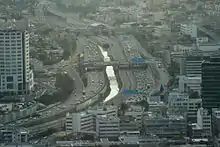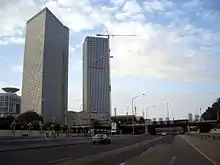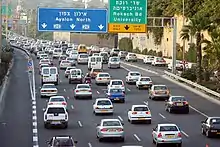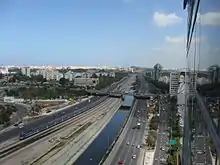 | ||||
|---|---|---|---|---|
| כביש 20 | ||||
| Ayalon Highway Hebrew: נתיבי איילון, romanized: Netivei Ayalon | ||||
 Arlozorov Interchange | ||||
| Route information | ||||
| Length | 29 km (18 mi) | |||
| Major junctions | ||||
| South end | Rishon LeZion (Holot Interchange) | |||
| ||||
| North end | Ga'ash | |||
| Location | ||||
| Country | Israel | |||
| Major cities | Holon, Herzliya, Bat Yam, Tel Aviv, Givatayim, Ramat Gan | |||
| Highway system | ||||
| ||||
Highway 20, more commonly known as the Ayalon Highway,[1] or simply Ayalon (Hebrew: נתיבי איילון, pronounced: Netivei Ayalon, lit. "Ayalon lanes"), is a major inter city freeway in Gush Dan, Israel. The road runs along the eastern border of central Tel Aviv from north to south (with a planned east-west branch as well) and connects all of the major highways leading to the city—such as Highway 4 from Ashdod and the Southern regions, Highway 2 from Haifa and the Northern regions, Highway 5 from the East, and Highway 1 from Jerusalem and the Southeast. The Ayalon Highway is heavily used; on an average day, almost 600,000 vehicles enter the freeway.[2] It consists of a multi-lane highway with a multi-track railway located between the opposite travel lanes. Some of the highway's route is along the Ayalon River, hence its name.
Background

Before the construction of the Ayalon Highway, all the major inter-city highways leading to Tel Aviv terminated in the outskirts of the city. This created major traffic congestion at the entry and exit points and made driving through the city difficult. Moreover, before the highway, Tel Aviv had two separate railway stations, one in the north and one in the south, which were not connected. Thus, passengers who wanted to travel to the South of the country could only do so from the southern station and those who wanted to travel to the North could only do so from the northern (Central) station. Even worse, trains from the northern part of the country could not travel to the southern part of the country without bypassing Tel Aviv from the east, making train travel in Israel challenging. Finally, there was the problem of the Ayalon River, which went through parts of Tel Aviv and would sometimes cause flooding.
To solve these problems, as early as the 1950s, ideas were raised regarding using the route of the river as a transportation corridor, but it wasn't until the mid-1960s that the government began planning. In the 1970s a government-owned company, Ayalon Highways Ltd., was set up to construct the highway. The first phase included the construction of a concrete channel for the Ayalon River to alleviate the flooding problem. In 1982, the first section of the road opened, and, in 1991, the final section of the central part of the road was completed. This section connects Highway 1 in the south with Highway 5 and Highway 2 in the north through the very center of the Gush Dan metropolitan area. The Ayalon Railway section of the Coastal Railway and four stations were built in the center of the highway, which provided for the long-sought connection of Israel's railway network through Tel Aviv.
In the early 1990s, the construction of a southern section of the highway had started. This section goes from Tel Aviv HaHagana railway station through the southern Tel Aviv suburbs of Holon, Bat Yam and Rishon LeZion and connects to Highway 4 north of Yavne. After the highway splits with the Ayalon River at Highway 1, it goes on the route of a road called Heyl HaShiryon Road (דרך חיל השריון, "The Armored Corps Road"), then on the route of Yigael Yadin Road until Wolfson Interchange, where it goes on the route of Yigal Allon Road (דרך יגאל אלון).
Previously, the northern terminus of the road was in Herzliya, but in January 2019 it was extended further north to near the kibbutz of Shefayim, where it has another connection to Highway 2 built as part of the Route 531 construction project.
Impact

The road and railway had a major impact on the Tel Aviv region. While quite congested at times it nevertheless alleviated traveling to and through Tel Aviv. Considerable real estate development of offices, shopping, and housing occurred along the route, so much so, that Tel Aviv's Central Business District lost much of its importance as many businesses relocated to near the road. Israel Railways saw huge increases in passenger numbers now that north/south trains could travel through Tel Aviv instead of around it.
Plans

The southern part of the highway (i.e., the section passing through the Holon, Bat Yam and Rishon LeZion suburbs) was completed in 2012, including a second overpass in the Holon interchange and dual track railroad and six stations in the median of the highway (as part of a project which extended the Coastal Railway to Ashdod). An east-west branch "Ayalon East", from Highway 4 to the Tel Aviv University railway station along the path of the Yarkon River has been planned, but is still not approved.[3]
The central section of the road is built along the banks of the Ayalon River. However, Israel Railways is in desperate need of adding a fourth railroad track in that area and no space exists to do so but "on top" of the river itself. Over the decades several suggestions have been made to solve this problem, ranging from diverting the entire river through Jaffa to building an elevated highway, to creating a man-made lake for capturing flooding overflow south of the city and burying the river in a large diameter pipe and constructing the railway on top of it. In 2018 a plan was finally approved to undertake a multi-billion Shekel project to add the fourth track although construction is not expected to commence until the early 2020s decade.[4]

Under construction as of 2020 are HOV lanes extending nearly the entire length of the Highway, together with large park & ride facilities located in the approaches to the Gush Dan region. These parking facilities will be served by free express public shuttle buses which will ferry passengers from the parking lots to various locations inside the Gush Dan metropolitan area via the new HOV lanes.[5]
The long-term projection is for Route 20 to run as far north as Hadera. However, this has garnered very strong opposition from environmental groups, since the road would have to cross a nature preserve and other sensitive environmental areas. These groups suggest widening Highway 2 (the so-called "Coastal Highway"), an existing freeway north of Tel Aviv which roughly parallels (several kilometres to the west) Route 20's future route, instead of extending Route 20 northwards.
Interchanges (South to North)

List of interchanges in order from the southernmost at Gan Sorek to the northernmost at Ga'ash:
| District[6] | Location[7] | km | mi | Name | Destinations | Notes |
|---|---|---|---|---|---|---|
| Central | Gan Sorek | 0 | 0.0 | מחלף חולות (Holot Interchange) | ||
| Rishon LeZion | 1 | 0.62 | מחלף מבוא איילון (Mevo Ayalon Interchange) | |||
| 3.5 | 2.2 | מחלף משה דיין (Moshe Dayan Interchange) | Named after Moshe Dayan | |||
| Tel Aviv | Bat Yam Holon | 5 | 3.1 | מחלף קוממיות (Komemiyut Interchange) | HaKomemiyut Street | |
| 6.5 | 4.0 | מחלף יוספטל (Yoseftal Interchange) | Yoseftal Blvd. | Named after Giora Yoseftal | ||
| 7.5 | 4.7 | מחלף דב הוז (Dov Hoz Interchange) | Dov Hoz Blvd. | Named after Dov Hoz | ||
| Holon Tel Aviv | 9 | 5.6 | מחלף וולפסון (Wolfson Interchange) | Heinrich Heine Street | Named after nearby Wolfson Medical Center | |
| Holon | 12 | 7.5 | מחלף חולון (Holon Interchange) | |||
| HaTikva | 13 | 8.1 | מחלף חיל השריון (Heil HaShiryon Interchange) | |||
| 13.2 | 8.2 | מחלף קיבוץ גלויות (Kibbutz Galuyot Interchange) | ||||
| 14 | 8.7 | מחלף לה גוורדייה (LaGuardia Interchange) | Laguardia Street | Named after Fiorello LaGuardia | ||
| Nahalat Yitzhak | 16 | 9.9 | מחלף השלום (Peace Interchange) | HaShalom Road | ||
| 17 | 11 | מחלף ארלוזורוב (Arlozorov Interchange) | Arlozorov Street | Named after Arlozorov | ||
| Bavli | 17.5 | 10.9 | מחלף ההלכה (HaHalakha Interchange) | HaRav Shlomo Goren Street | ||
| Shikun Lamed | 19 | 12 | מחלף רוקח (Rokach Interchange) | Rokach Blvd. | Named after Israel Rokach | |
| Afeka | 21 | 13 | מחלף קק"ל (KKL Interchange) | Keren Kayemet LeYisrael Blvd. | ||
| Ramat HaSharon | 23 | 14 | מחלף גלילות מזרח (East Glilot Interchange) | Named after the location of former Jewish refugee camp Glilot | ||
| Herzliya | 25.5 | 15.8 | מחלף שבעת הכוכבים (The Seven Stars Interchange) | |||
| Kfar Shmaryahu | 29 | 18 | מחלף המעפילים (HaMa'apailim Interchange) | Menachem Begin Blvd. | ||
| Central | Rishpon | 30.6 | 19.0 | מחלף שמריהו מזרח (East Shmaryahu Interchange) | ||
| Ga'ash | 34.6 | 21.5 | מחלף רשפון – געש (Rishpon – Ga'ash Interchange) | |||
| 1.000 mi = 1.609 km; 1.000 km = 0.621 mi | ||||||
Railway stations are located nearby the following interchanges (with station name in parentheses, if differs from interchange name): Shiv'at HaKochavim (Herzliyya), Rokach (University), Arlozorov (Tel Aviv Central), HaShalom, Kibbutz Galuyot (HaHagana), Holon, Wolfson, Yoseftal, Komemiyut, Moshe Dayan.
References
- ↑ Ayalon Highways, official website \ English
- ↑ "חברת נתיבי איילון בע"מ". Ayalonhw.co.il. Archived from the original on 2014-02-01. Retrieved 2014-02-24.
- ↑ "About the Ayalon East project, from the official website". Ayalonhw.co.il. Retrieved 2014-02-24.
- ↑ "Fourth Tel Aviv Ayalon railway track approved". Globes. 4 November 2018.
- ↑ "נתיבים מהירים" [Fast Lanes] (in Hebrew). Ayalon Highways. Retrieved 11 April 2020.
- ↑ Survey of Israel (October 31, 2018). "מחוזות משרד הפנים" [Ministry of Interior districts] (Map). Govmap (in Hebrew). Retrieved October 31, 2018.
- ↑ Survey of Israel (October 31, 2018). "גבולות ישובים" [Locality borders] (Map). Govmap (in Hebrew). Retrieved October 31, 2018.
External links
- Ayalon Highways Ltd. – Official site. Includes up to the minute traffic reports and live traffic camera views.
- Transport Today and Tomorrow
